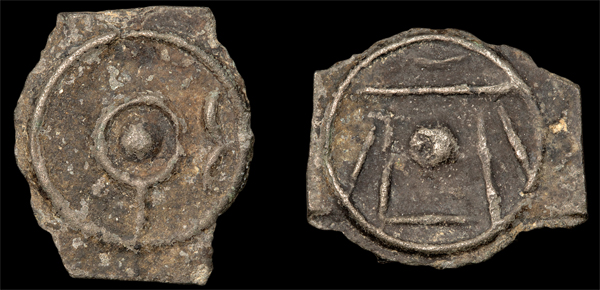
Unique ID: 114
This is a very late example of a “Flat Linear Potin”, and it is almost one of the last potins minted in Britain. These strange coins were cast in a tin-rich bronze, but we don’t know why. Their low value makes them the equivalent of small change, but their weights are too variable within a class to be treated as a currency, and transactions would have to be done by weight unless they were being used as trade tokens. They are dark in appearance, but would have been bright like silver when they were first made.
This coin is classed as a Holman G3/6-1 (Allen P1; VA 139-1; ABC 174). It’s not one of the published variants, although Holman does say “Attempting to detail the series to the same level as a thorough die study is probably futile, given that a minor subvariant could occur through something as simple as the moneyer sneezing while preparing the design, causing a slight but unintended change in that design” (see “A New Classification System for the Flat Linear Potin Coinage” by David Holman). This is because each coin seems to have been hand drawn in the mould, so each coin is different in some way. The final class was G4, and they are thought to be contemporary with G3, so it’s amongst the last minted in Britain. Class G coins are distinct from the earlier coins, having a reduced size and a crude appearance.
Holman suggests the date range for group G coins is 60/55 BC to 50/45 BC, although he does say “the dates given should only be accepted as notional ranges based on the currently very limited evidence”.
There are a significant number of Group G finds in Hertfordshire and up through Essex into the southern half of East Anglia. Group G4 is mainly found in West Essex and East Hertfordshire suggesting that it was minted by someone in that area. It’s possible it was the same tribe (perhaps the Segontiaci) who migrated from Kent to Essex and minted the British Le2 quarter staters (see 55, 56, 57, and 60). This coin is G3, not G4, so the distribution isn’t quite so clear cut. The majority of finds are in Kent, but the finds in the aforementioned areas are significant in number. It’s possible we’re looking at a tribe on the move, which might account for the crude design and smaller size. This is pure speculation though, so it remains assigned to the Cantiaci.
There are a number of ways to measure these coins. I normally record the maximum width (15.7mm), but for potins that includes the size of the remaining sprue, which isn’t indicative of the intended size. The minimum width (13.43 mm) is closer, but that can include flash overspill from the mould. The diameter of the containing circle (12.54mm) is probably the most useful measurement.
